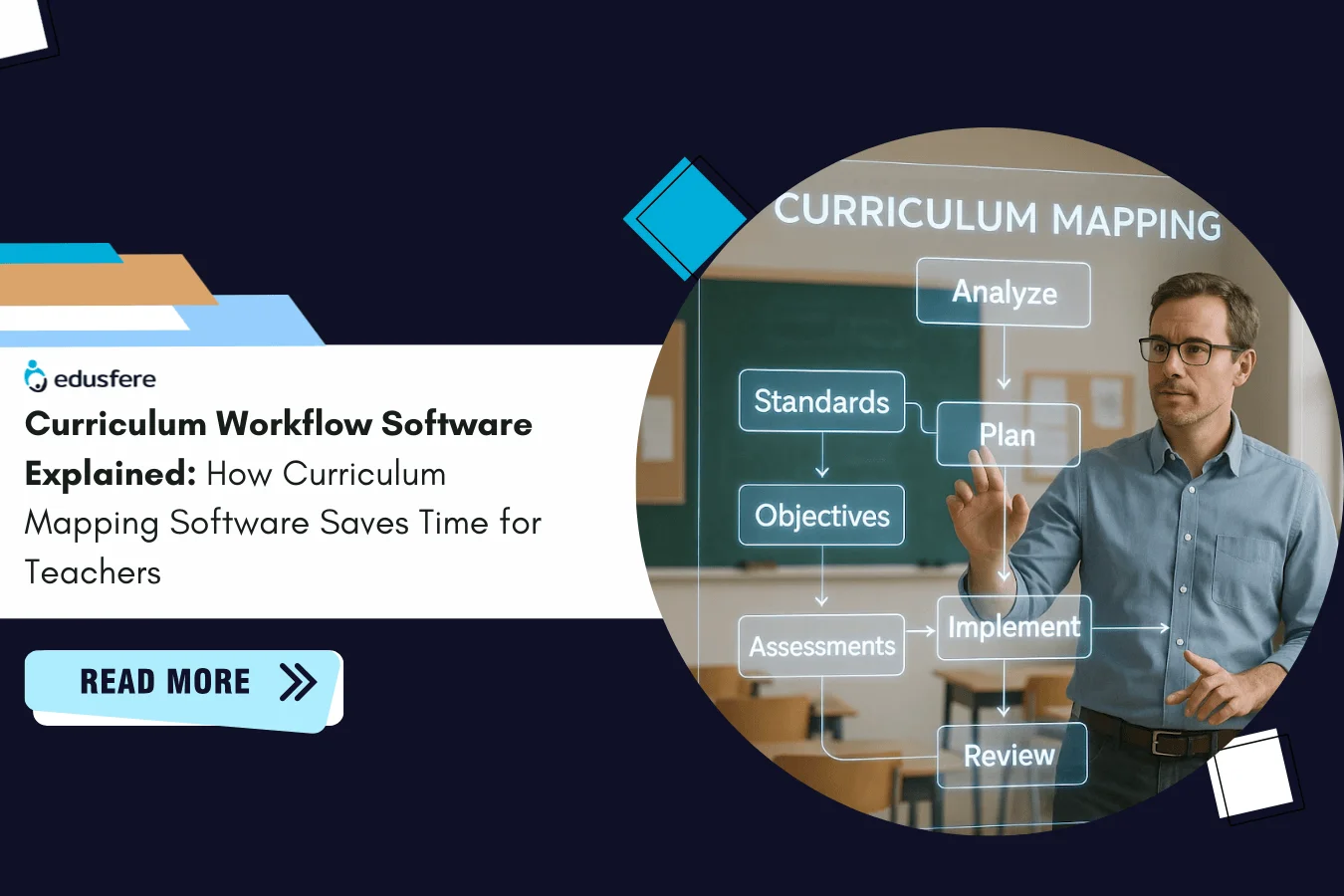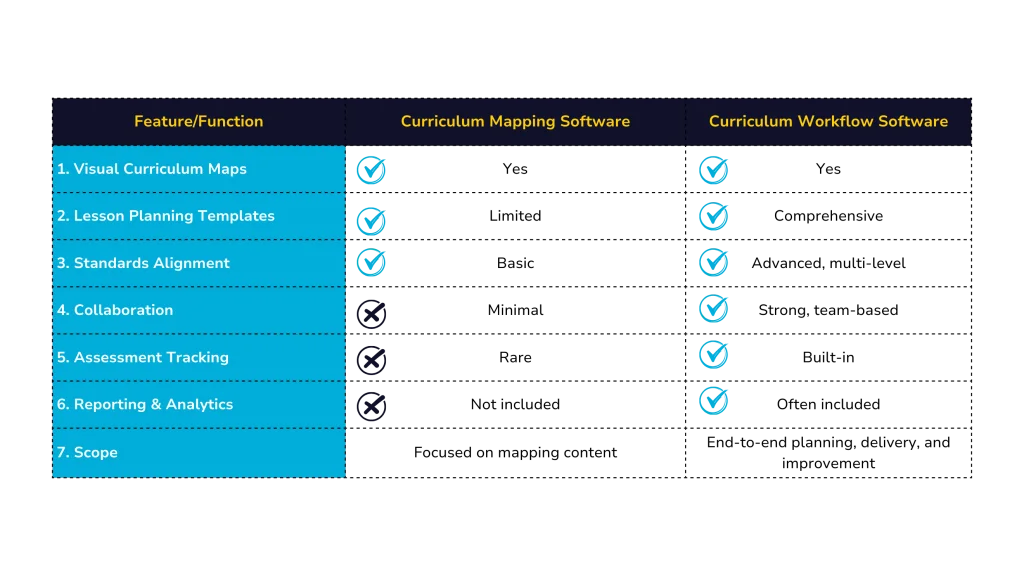Schedule a free demo to learn more
Curriculum Workflow Software Explained: How Curriculum Mapping Software Saves Time for Teachers
16th Sept 2025

Educators are expected to do more than ever before in the modern day fast-paced classrooms- design engaging lessons, align with national standards, personalize learning for diverse student needs and track progress in real-time. For many teachers, this often translates into late nights spent planning, cross-checking curriculum goals and managing scattered files across spreadsheets, word docs and paper binders.
This is where curriculum workflow software and particularly curriculum mapping software steps in as a game-changer. These tools simplify lesson planning, standard alignment and assessment tracking into a seamless digital workflow, helping teachers focus less on administrative overload and more on actual teaching.
In this blog, we’ll explain what a curriculum workflow software is, how curriculum mapping works and why adopting curriculum mapping software can save teachers hours of precious time every week.
What is a Curriculum Workflow Software?
Curriculum workflow software is a digital platform that streamlines the process of designing, organizing and implementing curriculum plans across grades, subjects and classrooms. Instead of juggling multiple documents, teachers can build structured lesson plans, align them with academic standards and visualize the progression of student learning, all in one place.
Key features of a Curriculum Workflow Software typically include:
- Curriculum mapping: A visual overview of topics, objectives and timelines.
- Lesson Planning Tools: Templates and scheduling for daily or weekly lessons.
- Standards Alignment: Easy integration with national or regional standards.
- Collaboration Options: Share and co-develop curriculum with colleagues.
- Assessment Tracking: Link formative and summative assessments directly to learning outcomes.
In short, curriculum workflow software acts as a command center for teachers’ planning process, reducing duplication of effort and increasing transparency across teaching teams.
What is Curriculum Mapping and why does it matter?
Curriculum mapping is the process of laying out what will be taught, when it will be taught and how it connects to learning goals. Think of it as a roadmapping for both teachers and students.
For example, in a science course, curriculum mapping ensures that foundational concepts (like cell structure) are taught before more complex topics (like genetics). It also helps avoid redundancy (repeating the same content across grades) and identifies gaps where key topics may be missing.
Traditionally, curriculum mapping has been a tedious, paper-based process that required countless hours of coordination. But with a robust curriculum mapping software, teachers can create, edit and visualize these mappings with just a few clicks, dramatically cutting down on planning time.
A modern curriculum mapping software platform brings agility, alignment and accountability to your curriculum management process. This article provides great insight into ‘Choosing the Right Curriculum Mapping Software’.
Curriculum Workflow Software vs. Curriculum Mapping Software: What’s the difference?
Many educators use the terms interchangeably, but there is an important distinction. A curriculum mapping software focuses primarily on creating and visualizing curriculum maps, essentially the “what” and “when” of teaching. It helps teachers lay out topics, units and standards in a structured sequence.
A Curriculum Workflow Software, on the other hand, includes curriculum mapping as one feature but goes further. It manages the entire teaching workflow, from planning and collaboration to assessment tracking, reporting and continuous improvement.
In other words, curriculum mapping software is a subset of curriculum workflow software. Here’s a breakdown:

If your goal is to design curriculum maps, a curriculum mapping software may be enough. But if you need a comprehensive tool that manages planning, teaching, collaboration and reporting, curriculum workflow software provides a more complete solution.
How Curriculum Mapping Software saves teachers time
One of the biggest challenges teachers face is balancing curriculum design with daily teaching responsibilities. Here’s how a curriculum mapping software like Edusfere helps teachers save hours:
1. Eliminates manual work
Without digital tools, teachers often spend hours formatting lesson plans in spreadsheets or Word documents. With curriculum workflow software, they can use ready-made templates, drag-and-drop lesson components and automatically link lessons to standards.
Time saved: 3 – 5 hours per week (approx.)
2. Streamlines collaboration
In most schools, multiple teachers teach the same grade or subject. A curriculum mapping software allows teachers to collaborate on shared curriculum plans in real time, instead of exchanging endless email attachments.
Time saved: Countless hours of back-and-forth communication.
3. Improves transparency and alignment
School administrators often require proof of alignment with standards or evidence of coverage across subjects. Instead of preparing separate reports, teachers can generate instant overviews directly from their curriculum workflow software.
Time saved: Several days during audit or review season.
4. Reduces redundancy
When curriculum mappings are digitized, teachers can see what has already been taught in previous years. This prevents duplication of lessons and ensures a logical progression of knowledge.
Time saved: Hours of repetitive content creation.
5. Supports quick adjustments
If a class falls behind schedule due to unforeseen events (exams, field trips, or school closures), teachers can quickly adjust the pacing guide in the software, without needing to reformat entire lesson plans.
Time saved: 1-2 hours every time adjustments are required.
Best Practices for Using a Curriculum Workflow Software
To get the most out of curriculum workflow software, teachers can follow these best practices:
- Start Small by mapping out one subject or grade level before expanding to all.
- Leverage Templates using built-in lesson plans and mapping templates instead of building from scratch.
- Collaborate Early by involving colleagues in the mapping process to ensure consistency across classrooms.
- Update regularly to keep curriculum mappings dynamic by revisiting them after each term.
- Integrate Assessments by linking quizzes, assignments and projects directly to curriculum goals for better tracking.
Real-world Impact: Teachers reclaiming their time
Studies have shown that teachers spend up to 11 hours per week on lesson planning and preparation. By digitizing curriculum mapping and workflows, educators report cutting planning time by nearly half, while also improving lesson quality.
For schools in resource-constrained environments, adopting a free curriculum mapping software can make professional planning tools accessible without extra costs. This directly contributes to teacher well-being, reduced burnout and ultimately, better learning outcomes for students.
The classroom of the future isn’t just about smartboards and tablets, it’s also about smarter ways to plan and manage the curriculum. Curriculum workflow software is redefining how educators design and deliver lessons, ensuring that time spent outside the classroom is efficient and purposeful.
By starting with a curriculum mapping software, teachers can save hours each week, collaborate more effectively and focus on what truly matters: inspiring and educating their students.
At Edusfere, we believe the right tools can transform teaching. If you’re looking to streamline your lesson planning and tackle important curriculum documentation without missing a step, try adopting curriculum workflow software and experience how technology can give you back valuable time.